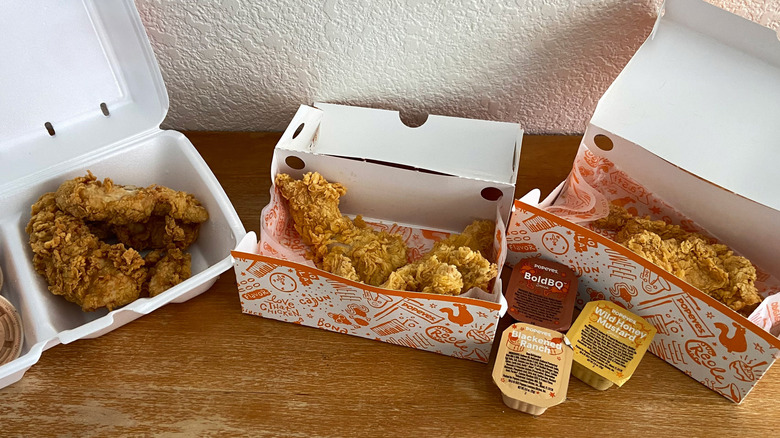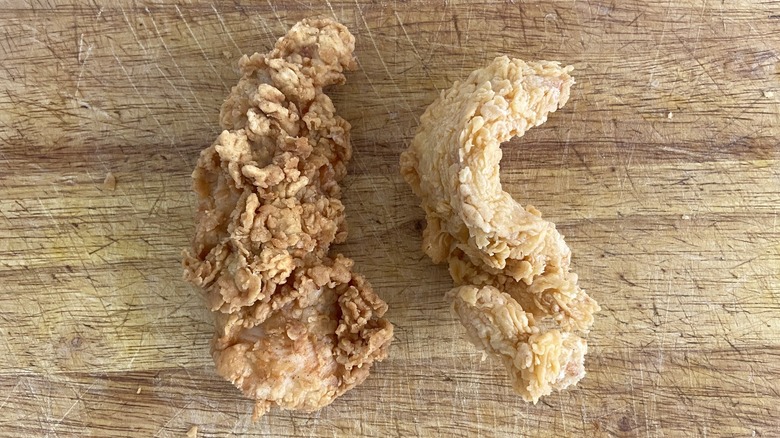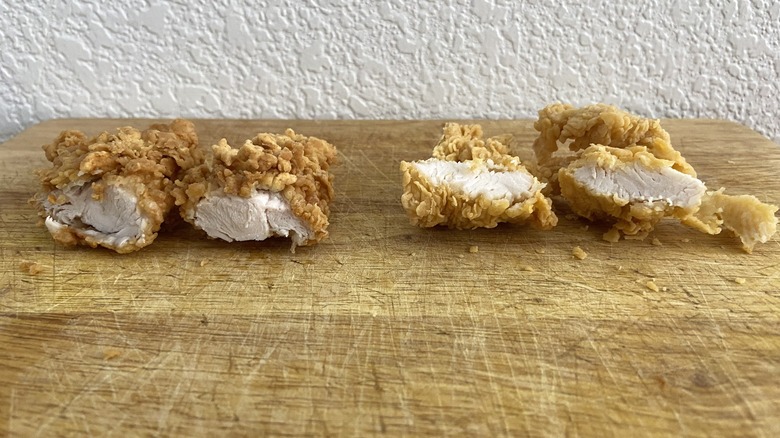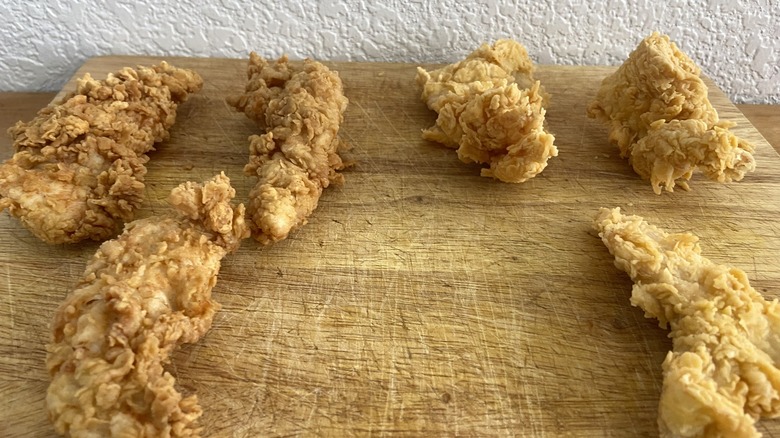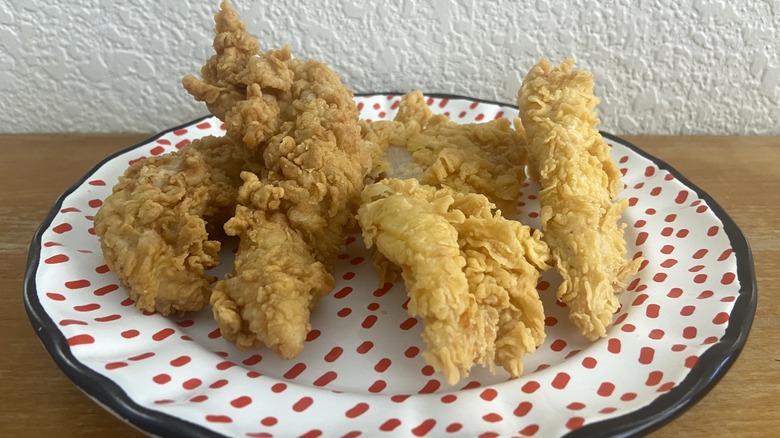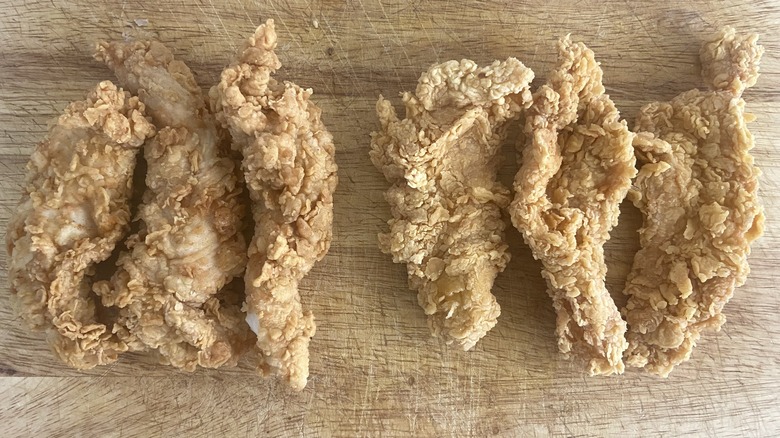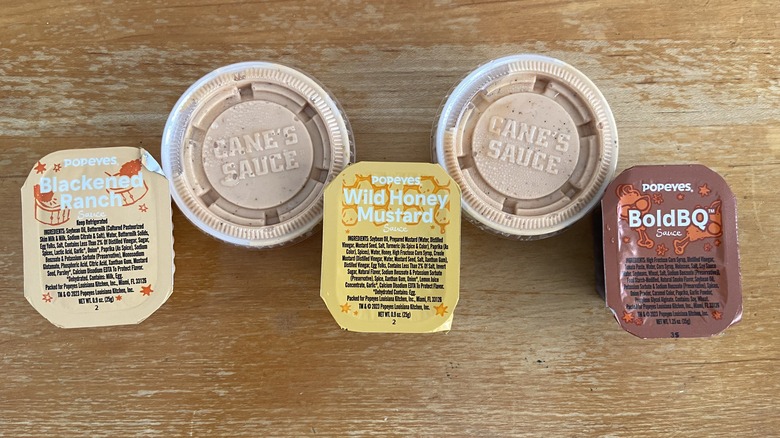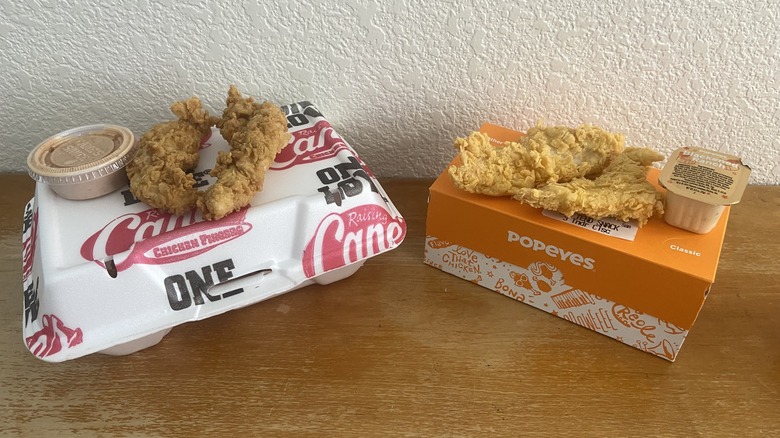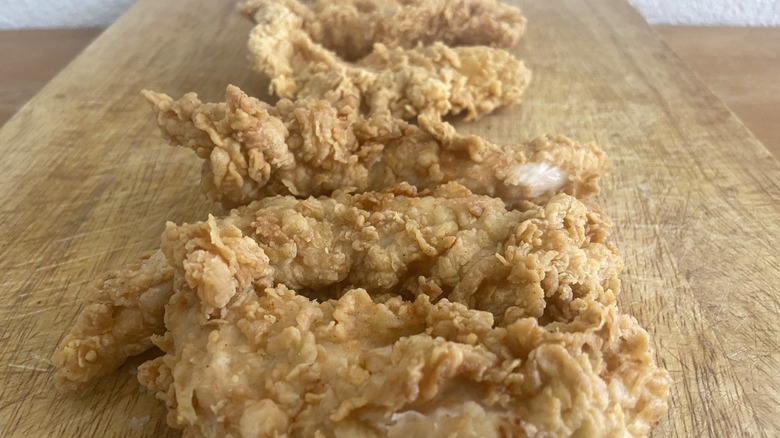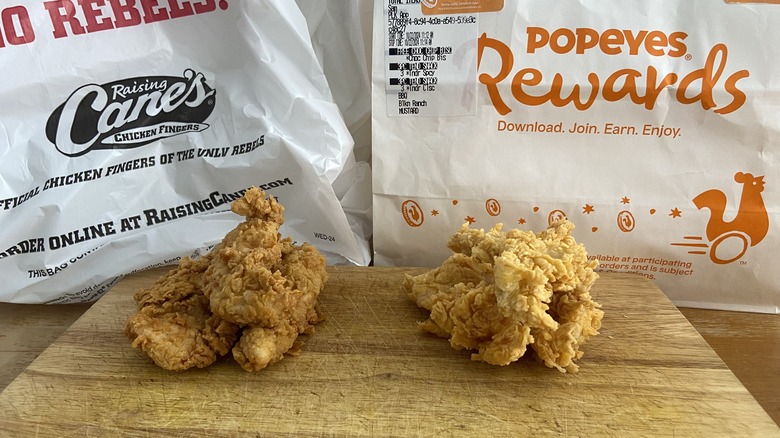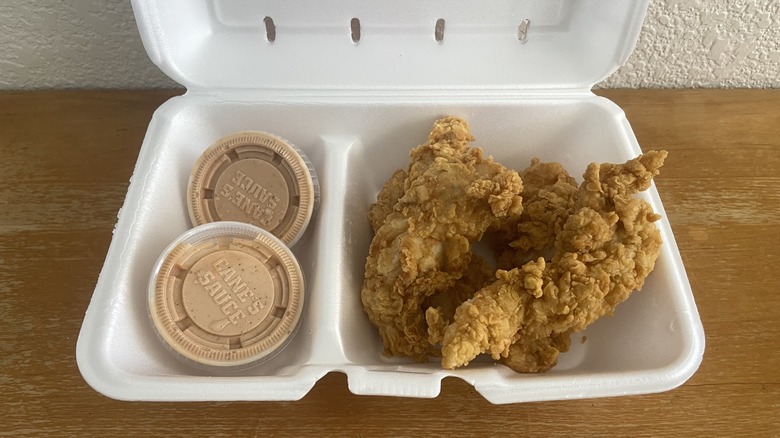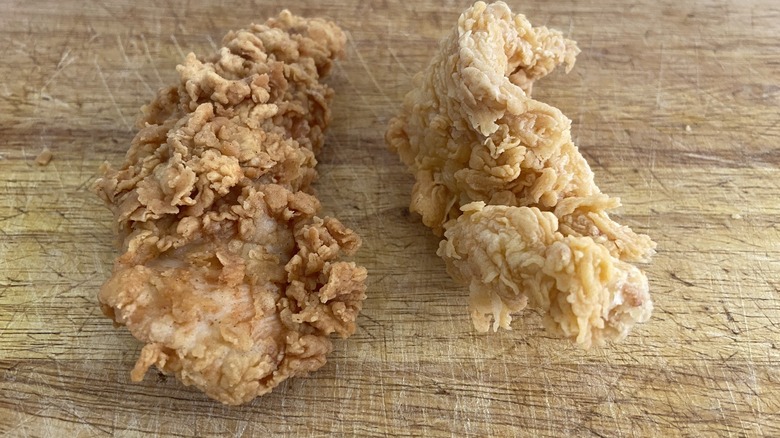Popeyes Vs Raising Cane's: Who Makes The Best Chicken Tenders?
Popeyes and Raising Cane's are both fast food fried chicken chains, but their individual approaches to how they serve fried chicken could hardly be more different. At Popeyes, customers can choose between traditional chicken, the famously delicious Popeyes chicken sandwich, sauced wings, and tenders. Also on the menu are a couple of fried seafood items, plenty of sides, and some dessert options. Meanwhile, the Raising Cane's menu is deliberately minimalist, mostly consisting of tenders, sauce, slaw, and Texas toast in various permutations. That extends to a sandwich option, which incorporates three tenders as its protein rather than a bespoke chicken patty.
Beyond just each chain's distinct fried chicken philosophy, the tenders at Raising Cane's are pretty plain on their own, effectively requiring a side of Cane's Sauce for dipping. Unsurprisingly, the outwardly Louisiana-branded Popeyes chain seasons its tenders more by default. I visited my nearest Popeyes and Raising Cane's locations and ordered tenders from each in order to determine which chicken chain does them best. While there's only one kind of tender at Cane's, Popeyes offers classic, spicy, and blackened options. The blackened tenders are un-breaded, making them different enough from the Raising Cane's tenders that I decided to dismiss them from this competition. I did, however, order both classic and spicy tenders to reflect the variety uniquely available at Popeyes. With that said, here's how the tenders from both chains compare in a variety of categories, as well as my pick for the spot with the superior chicken tenders.
Whose tenders look better?
It's safe to say that the chicken tenders from Popeyes and the storied Raising Cane's chain look more similar than they look different. Based on the few factors that do actually differentiate them from one another, I found that Raising Cane's makes the more visually appealing product.
What's most immediately apparent is that the Raising Cane's tenders are darker in color than the Popeyes tenders — the spicy variant is just barely a darker shade of tan yellow than original, but they're both in the same ballpark. Something about that darker color looks indicative of a richer flavor. Getting slightly more granular, the cragginess of each style of tender diverges somewhat in that the breading on the Popeyes tenders is a little flatter and flakier, whereas the Raising Cane's tenders are covered in a thicker and rounder breading. On a related note, the sort of lighter Popeyes breading more readily falls off, exposing plain chicken and detracting slightly from their appearance. My Raising Cane's tenders largely retained their breading throughout my meal. So, while its tenders might not look radically different from the competition at Popeyes, a more appetizing color as well as a more visually robust and structurally superior breading clutches the win for Raising Cane's in the looks category.
How does the quality of each chain's chicken stack up?
After I tried bites of plain chicken from the interiors of both Raising Cane's and Popeyes chicken tenders, I found the chicken at Raising Cane's to be of a higher quality than the chicken at Popeyes. The Popeyes chicken is a little softer, and to its credit, tastes like it was marinated in a spice blend before it was breaded. That said, it's also a little stringier, whereas the Raising Cane's chicken is firmer and more readily retains its structure. Cane's chicken may not be spiced to the same extent, but an overall higher level of quality is pretty clear.
While the nitty gritty details of how both chains procure and prepare their chicken may not be matters of public record, one key factor that makes Raising Cane's chicken so delicious is its commitment to using richer tenderloin meat in what the chain officially considers chicken fingers. Technically, chicken fingers and chicken tenders aren't the same thing. Comparatively, the fact that Popeyes claims to use regular chicken breast meat rather than tenderloin became the subject of a class action lawsuit — the full text of which is available on the Truth in Advertising website — alleging that the term "tender" should exclusively refer to chicken strips made with breast tenderloin meat. That class action lawsuit seems to have had no effect on Popeyes, which continues to offer so-called tenders to this day despite an apparently lower quality chicken.
How are the tenders seasoned?
Fans and critics of the chain alike can agree that Raising Cane's chicken is relatively unseasoned. Dipping them in its signature Cane's Sauce, rather, is what grants the chain's tenders a robust flavor more typical of fast food. It should come as no surprise, then, that Popeyes seasons its chicken more than Raising Cane's.
For what it's worth, Cane's chicken doesn't taste like mere breaded chicken. Rather — and especially with few competing flavor components — a prominent buttermilk flavor introduces at least some complexity. Meanwhile, a Cajun spice blend is perceptible in both the chicken and breading at Popeyes. My one significant complaint about the seasoning at Popeyes is that my order of spicy tenders didn't even taste perceptibly spicy. Instead of, say, some additional hot pepper component, to my palate the spicy tenders seemed to simply incorporate more of whatever provides the default Cajun spice blend with its heat. Spicy or not, that spice blend is still a bit more interesting than the relative lack of spices at Raising Cane's, giving the edge to Popeyes in a strict seasoning battle.
Which chain uses better breading?
By volume, breading may only be a fraction of each individual chicken tender, but it still handles plenty of heavy lifting. Poor breading can ruin fried chicken. Think back to eating, say, a fried chicken leg, and biting into pure chicken after a big chunk of breading has inevitably come off in a previous bite. That pure chicken bite is a huge downgrade. A fried chicken tender, then, can live or die on the quality of its breading. I had a few bites of just the outer breading from each chain in order to determine how Popeyes and Raising Cane's each handles this key component of its chicken tenders.
On my Popeyes tenders, the breading was slightly crispy — albeit a little flaky — and lightly seasoned. Something about that seasoning reminded me of a store-bought frozen chicken nugget, though Cajun flavors played a part too. The breading on my spicy tenders tasted just about the same, suggesting the extra spice is in the marinade and not the coating. The breading on my Cane's tenders was noticeably crispier. And, while it wasn't spiced the same, the Cane's breading pulled off a pleasant flavor anyway based on just crisped up, deep-fried flour and buttermilk. Like in the chicken category, even if Popeyes is attempting to do more in the flavor department, I ultimately found the Raising Cane's breading to be of an overall higher quality.
How do their sizes compare?
To customers without a discerning palate — which is absolutely valid, especially when ordering fast food — flavor might not play as big of a role as sheer quantity. Plus, it's hardly controversial to suggest that biting into a big, juicy tender is more viscerally satisfying than nibbling on a smaller, skinnier chicken finger. With that said, there wasn't a huge discrepancy in size between my tenders from Raising Cane's and my tenders from Popeyes, though I did find that one chain came out ahead.
Based on some loose measurements, I determined that my Raising Cane's tenders averaged about 4.4 inches by 1.25 inches. While that former number is weirdly specific, all of my tenders were about 4.5 inches in length save for one smaller one, hence slightly lowering the number after the decimal. My Popeyes tenders averaged 4.5 by 1.5 inches, and the biggest piece from either chain was an original Popeyes tender measuring 5.5 by 1.5 inches. For what it's worth, I've been to this particular Raising Cane's location plenty of times, and found that the tenders they served me on this visit were a little bigger than usual. Based on both my scientific and anecdotal findings, then, Popeyes serves bigger tenders than Raising Cane's.
Whose sauce is better?
While Raising Cane's famously offers just its secret-recipe Cane's Sauce — and, technically, containers of industry-leading Heinz Ketchup, even if that's more for its fries — at Popeyes customers can choose from among eight sauce options. Rather than try all of them, I opted for BoldBQ, Blackened Ranch, and Mardi Gras Mustard. Since as far as I know, there's no general consensus for Popeyes' best option, I picked what I felt was the widest variety of flavors.
First off, of the three Popeyes sauces I tried, the BoldBQ was far and away the best. True to the fact that it's not simply called BBQ sauce, it tasted quite a bit tangier and considerably spicier than a standard BBQ option. The Mardi Gras Mustard was a straightforward fast food approximation of a stone ground mustard, which I found just slightly above average as a dipping sauce. Finally, the Blackened Ranch was not perceptibly spicy or even all that flavorful. With that said, not even the Bold BQ sauce could hold a candle to the sweet, tangy, plussed-up Thousand Island at Cane's. To verify my findings, I committed light sacrilege and tried every tender in every sauce. A Cane's tender in Cane's Sauce was my favorite bite, followed by a Popeyes tender in Cane's sauce. For what it's worth, Popeyes' BoldBQ should not be underestimated, but it simply can't hold up to one of the very best dipping sauces at any fast food chain.
Which tenders are more customizable?
Even Raising Cane's fanatics will readily admit that customization is not one of the chain's strong suits. That said, customization isn't entirely lacking on the Raising Cane's menu. Of course, the primary choice most customers have to make is between a three-piece, four-piece, and six-piece combo. Each of those comes default with Texas toast, fries, slaw, sauce, and a drink — though Cane's pros know to sub that slaw out for an extra sauce. Tenders and sauces are also offered à la carte on the Cane's sides menu. For this exercise, I simply ordered four tenders and two sauces.
Just like at Cane's, Popeyes offers tender combos in a variety of sizes. Plus, three-piece and five-piece tender orders specifically can come à la carte rather than with sides and a drink, albeit still with a dipping sauce or two from among the eight aforementioned options. Popeyes also sells classic, spicy, and blackened tenders as opposed to the single preparation at Cane's. While the ability to order individual tenders in any quantity is a point in favor of Raising Cane's, a variety of flavors and a greater number of sauces ultimately adds up to a more robust range of customization options at Popeyes.
How do they compare nutritionally?
An order of three tenders at Popeyes totals 450 calories, 21 grams of fat, 9 grams of which are saturated fat, 1 gram of which is trans fat, 100 milligrams of cholesterol, 1820 milligrams of sodium, 29 grams of carbs, 2 grams of fiber, and 38 grams of protein. That same quantity of three tenders at Raising Cane's adds up to 390 calories, 18 grams of fat, 3 grams of which are saturated fat, 120 milligrams of cholesterol, 570 milligrams of sodium, 15 grams of carbs, 3 grams of fiber, and 39 grams of protein.
Save for a highly specific case where 20 additional milligrams of cholesterol might make a difference, Raising Cane's tenders can be considered the nutritionally preferable option by virtually every metric — notably including their lack of trans fat, which health professionals like Harvard Health Publishing consider technically unsafe to consume. Meanwhile, one-ounce sauces at Popeyes range from 40 to 140 calories, 0 to 15 grams of fat, 140 to 450 milligrams of sodium, and 0 to 16 grams of sugar. A 1.5-ounce serving of Cane's Sauce comes out to 190 calories, 19 grams of fat, 580 milligrams of sodium, and 4 grams of sugar. Even after accounting for discrepancies in serving size, it is technically possible to choose a healthier sauce at Popeyes. That said, sauce usage can vary drastically depending on each individual consumer. Cane's, then, remains the more nutritious option.
Whose tenders are a better value?
While most Raising Cane's locations are company-owned, Popeyes is predominately franchised. As a result, Popeyes prices are more likely to vary based on location than the prices at Raising Cane's. In fact, one order of three chicken tenders at my nearest Popeyes costs $1.20 more than the same thing at a location just a few miles away. For the sake of presenting Popeyes in the best possible light, I'm using prices from the cheaper location rather than the one I visited.
At that Popeyes, a three-piece order of chicken tenders — including one sauce — totals $7.79, whereas a combo with one side, one drink, and one biscuit is $10.79. Five pieces with two sauces are $10.99 à la carte or $12.99 in a regular combo. At Raising Cane's, I paid $1.81 per tender and $0.39 per sauce. Three tenders and one sauce, then, are $5.82. Furthermore, a three-piece combo is $9.89, while a six-piece combo totals $16.59. That six-piece combo actually costs more than a three-piece with side orders of three tenders and a sauce, but it does come with a larger drink. Even if the six-piece combo is arguably not as good of a deal as the Popeyes five-piece combo, individual tenders and sauces otherwise costing quite a bit less makes Raising Cane's the altogether thriftier option.
The best chicken tenders are from Raising Cane's
To start, it's worth taking stock of the fact that Raising Cane's played on its home court as a business dedicated almost wholly to chicken tenders. Away teams still win plenty in sports, of course, so that's not necessarily an unfair advantage, but an advantage nonetheless. As it turns out, Cane's did indeed secure the win on its home court.
First off, the numbers reflect this. I found that Cane's came out ahead in six categories versus Popeyes' three. Furthermore, I consider Popeyes' wins in the size and customization categories less important than the fact that Cane's tenders taste better by every metric other than how they're seasoned when eaten plain. The Popeyes chicken tenders aren't bad by any means — especially with the help of the BoldBQ sauce, Popeyes is a serviceable tender chain. But as long as there's a Raising Cane's nearby, there are few reasons outside of affinities for specific Popeyes flavors to opt for its tenders instead. In the end, the simplicity of Raising Cane's is to its benefit, because what they do they do better than the competition.
Methodology
To start my chicken tender head-to-head, I ordered three classic Popeyes tenders, three spicy tenders, one BoldBQ sauce, one Blackened Ranch sauce, and one Mardi Gras Mustard online from a nearby location in the Las Vegas area. After picking up my Popeyes order, I ordered four chicken fingers and two Cane's Sauces in the drive-thru of the nearest Raising Cane's.
I brought both orders home and ate everything in one sitting. A few tenders I dissected or ate differently than I would normally — dipping them in the opposing chain's sauces, for example — for the sake of categories that required specific information. Then I ate roughly the second half of my order as if it were on my own time to ensure I had my food from both chains at their most enjoyable. Other than my one mention of the usual size of tenders from this particular Raising Cane's location, all findings and opinions are based solely on this meal and not my past experiences with either chain.
